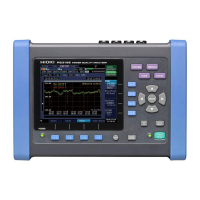1.1 Procedure for Investigating Power Supply Quality
16
Check the following:
Step 2: Identifying the malfunctioning component (measurement location)
Where is the issue occurring?
• Principal electrical system
(Large copier, uninterruptible power supply, elevator, air compressor, air conditioning compressor, battery
charger, cooling system, air handler, time-controlled lighting, variable-speed drive, etc.)
• Electric distribution system
(Conduit [electrical conduit] damage or corrosion, transformer heating or noise, oil leak, circuit breaker
operation or overheating)
1
When does the issue occur?
• Does it occur continuously, regularly, or intermittently?
• Does it occur at a specific time of day or on a specific day?
2
What type of investigation (measurement) should be performed to find the cause?
(It is recommended to measure voltage, current, and possibly power continuously. By analyzing voltage and
current trends when the issue occurs, it will be easier to pinpoint the cause of the problem. Additionally,
simultaneously measuring multiple locations is an effective way to quickly identify the cause.)
• Electrical substation internal lines (power companies only)
• High or low voltage at a service line entrance
• Distribution boards and switchboards
• Outlets and other points of power supply for electric and electronic equipment
3
What is the expected cause?
• Voltage abnormalities (RMS value fluctuations, waveform distortion, transient voltages, high-order har-
monics [noise at frequencies of several kHz and above])
• Current abnormalities (leak current, inrush current)
4

